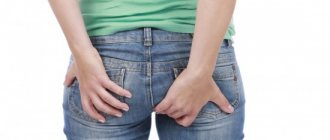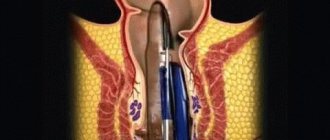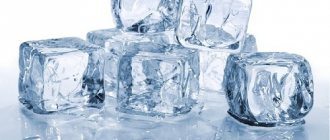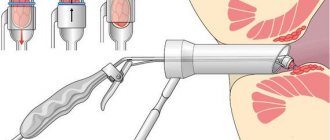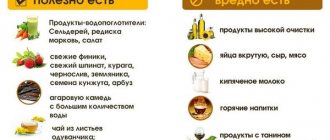Unfortunately, hemorrhoids, which are not a childhood problem, also occur in children. To determine how to treat hemorrhoids in children, it is necessary to understand the causes of its occurrence and the characteristics of the course of the disease itself, since doctors say that there are differences compared to adults and they are very significant.
Causes causing the development of hemorrhoids in children
- Constipation. As you know, constipation can occur not only in adults, but also in children, and even in infants. And if in the first year of life a child’s constipation is a consequence of a violation of the microflora in the intestines, then in older children this problem is associated with poor nutrition. Chips, crackers, soda, lack of hot food, lack or a small amount of vegetables in a child’s diet, all this can lead to the development of “adult” hemorrhoids in a child. Constipation is dangerous because dense stool during defecation can disrupt the rectal mucosa, which is a very serious risk factor. In addition, when defecating, the child tries to “squeeze” feces out of himself, which creates excess pressure and also contributes to the formation of hemorrhoids.
- Sitting on the potty for a long time. Very often, especially in kindergartens, children are put on the potty not taking into account their biological rhythms, but according to a schedule. We ate, went potty and went to bed. But the child cannot poop and is forced to sit waiting for the event. At this moment, the veins of the rectum begin to fill with blood. This is an ideal situation for the development of childhood hemorrhoids.
- Prolonged crying. This factor has a particularly strong influence on the development of hemorrhoids in the first year of a child’s life. Due to crying, the pressure inside the abdominal cavity increases and blood begins to accumulate in the pelvis. Congestion occurs and, as a result, hemorrhoids develop.
- Congenital changes of veins. This pathology exists and is noticeable from the first days of life. When a child cries or defecates, bulging veins are noticeable. It is possible to treat this pathology, but this should only be done by a specialist.
- For school-age children, the cause of hemorrhoids can be a sedentary lifestyle. Sitting at a desk at school and then in front of a computer monitor in no way promotes good blood circulation, and this risks developing hemorrhoids.
- It happens that high school students secretly begin to drink alcoholic beverages. Children's bodies are very sensitive to alcohol. In this case, blood microcirculation may be disrupted, including in the pelvis, which leads to the appearance of symptoms of hemorrhoids.
Prevention and conclusions
To prevent varicose veins of the rectum, it is necessary to hold conversations and debates with school-age children about the obligation to maintain an active lifestyle. They should be encouraged to engage in active sports and told about the inadmissibility of bad habits. Proper nutrition is also an important component of prevention. Be sure to eat summer vegetables and reduce fatty foods and unhealthy foods to a minimum in your diet. Eating fruits and vegetables during the summer holiday helps to generally strengthen the body. This diet helps prevent constipation. In the summer, predisposing factors occur less frequently, since the diet is more balanced and sedentary time is reduced to a minimum.
Hemorrhoids in childhood are not a common, but extremely unpleasant disease for both children and parents. Hemorrhoids tend to appear suddenly. For such a serious problem as childhood hemorrhoids, treatment should be prescribed by a specialist. Only a pediatrician can prescribe adequate treatment, and self-therapy is unacceptable.
Treatment of hemorrhoids in children 3-4 years old
The first thing parents should understand is that hemorrhoids in a child should be treated only under the supervision of an experienced doctor. There should be no self-medication! As for treatment methods, both for adult hemorrhoids and for children’s hemorrhoids, conservative and surgical treatment are divided. Conservative methods of treatment include the use of ointments and suppositories.
There are no special children's medications for hemorrhoids. Doctors use drugs for adults (not all of them can be used to treat the disease in children), very carefully recalculating the dosage of drugs taking into account the age and weight of the child.
Among the drugs that can be used are suppositories:
- Relief;
- Ginkor Procto;
- Hepatrombin B;
- Candles with sea buckthorn oil.
Some of these drugs are also available in the form of ointments and are also used in accordance with the doctor’s recommendations. In addition to medications, the doctor may prescribe a special massage, which gives very good results, but has a number of contraindications.
This:
- Tuberculosis of the intestines or abdominal cavity;
- Predisposition to bleeding;
- Tumors in the abdominal cavity;
- The presence of gastrointestinal diseases that are in the acute phase;
- The presence of acute inflammatory diseases of internal organs.
In some cases, surgery cannot be avoided. This happens quite rarely, but such cases do occur. The operation is performed under general anesthesia and involves excision of nodes and suturing of blood vessels.
Treatment of hemorrhoids in adolescents 11-14 years old
There is no fundamental difference in the treatment of adolescents from the treatment of younger children. The same drugs are recommended, but with an adjustment regarding dosage. The only thing that can be included additionally is the use of various traditional medicines, mainly in the form of baths and microenemas.
Some frequently used recipes include:
- Sitz bath of calendula, chamomile and string. To do this, prepare a mixture of herbs (three tablespoons each) and brew them with a liter of boiling water. Take the bath every other day. The minimum number of sessions is ten. Session duration 15 minutes;
- Microenema with sea buckthorn oil. For a microenema, take 60 grams of sea buckthorn oil and heat it to a temperature of 356 degrees. After this, the oil is injected into the anus using a bulb. The child should try to hold the oil by lying on his side for at least 15 minutes. This microenema promotes the healing of microcracks and also normalizes the child’s stool.
Complications of hemorrhoids
Complications of any disease can be avoided with timely treatment. To prevent the progression of the disease, you should definitely consult a doctor. Common complications of a chronic disease include anemia due to constant blood loss or occurring during the postoperative period. Inflammation of varicose nodes of the anus is possible. Inflammation can spread to the peri-intestinal tissue. Subsequently, a cellulitis or abscess forms. Infection is always accompanied by a rise in temperature to febrile levels.
Folk remedies for the treatment of hemorrhoids in children
Traditional medicine also has in its arsenal many means of treating hemorrhoids in children. However, these remedies should only be used after consultation with your doctor.
- Lotions with potassium permanganate solution . A very effective remedy for the prevention and treatment of hemorrhoids, including in children. A very weak solution of potassium permanganate (light pink) should be used, otherwise you can burn the child’s delicate tissues and thereby aggravate the disease;
- Lotions from herbal decoctions . The leaders on this list are chamomile, calendula, celandine and St. John's wort. To prepare the decoction, take two or three tablespoons of flowers and pour one glass of boiling water. After the broth has infused (about half an hour), the gauze is moistened with the broth and applied to the sore spot for 15 minutes. After this, the procedure should be repeated;
- Potato candles . A well proven product. A candle is cut out of peeled potatoes for rectal use without sharp corners. Leave it overnight. In the morning the suppository will come out on its own with the feces;
- Candles made from crystallized honey. For such candles, honey collected at least two years ago and turned into a dense, sugared mass is suitable. The candle is cut out and placed overnight. In the morning, the remains of the suppository will be passed out in the feces. Honey has a wound healing and anti-inflammatory effect;
- Red rowan juice . Unfortunately, this method of treatment is only available in the fall, but this method has a lot of adherents because it is as safe as possible. Ripe rowan berries are washed and the juice is squeezed out. For one application you need 100 grams of juice. You should drink it for 12 days, three times a day before meals. If the child does not like the taste of rowan juice, it can be mixed with other juices or immediately washed down with clean water;
- Cocoa butter ointment. To prepare such an ointment, take 50 grams of butter and melt it in a water bath. Add the same amount of olive oil to the melted butter. Mix everything well and let cool. This ointment should be stored in the refrigerator. Can be used after each bowel movement;
- Red beet juice . Drink freshly squeezed red beet juice for hemorrhoidal bleeding. You should drink 50 milliliters before meals 3-4 times a day for two weeks.
Symptoms
Signs of hemorrhoids in young children under 3 years of age are not easy to notice. Most children at this age cannot describe their feelings and complain to their parents.
Hemorrhoids in a child are manifested by strong straining during bowel movements. The baby experiences pain and burning, so it begins to cry and be capricious. Immediately after defecation, you need to examine the stool for blood and the anus. In a sick baby, the vascular network will be visible near the anus.
Hemorrhoids in a 3-year-old child can be recognized by the following symptoms:
- increased irritability;
- tearfulness;
- scratching the anorectal area and buttocks;
- blood in stool;
- difficulty with bowel movements;
- slightly protruding anus.
A child over 5 years old may complain of burning, pain and itching.
Symptoms in girls and boys over 14 years of age are similar to those in adults. Hemorrhoids in adolescents are manifested by burning and itching in the anal area, a sensation of a foreign body in the rectum, a feeling of incomplete bowel movement, pain during bowel movements, as well as bloody discharge from the anus.
These symptoms may also indicate other diseases, such as polyps or tumors.
Prevention of hemorrhoids in children
To prevent hemorrhoids in children, you should follow a few simple requirements:
- Regularity of nutrition in combination with an “anti-constipation” diet. This requirement means compliance with the regularity of the child’s food intake, its balance in terms of the amount of vegetables and fruits, as well as compliance with standards for the fluid content in the child’s diet. You should also avoid fried foods whenever possible. Including fermented milk products in the diet, which can significantly soften stool;
- Take care of the condition of the intestinal microflora. Quite often, for various serious illnesses, a child is given antibiotics, which have a detrimental effect on the intestinal microflora. Do not forget about the mandatory inclusion of lactobacilli in the course of recovery after taking antibiotics;
- Have several conversations with the child and teach him the “correct” bowel movement. This means without a long “meeting” and strong straining. To do this, a small child should have a comfortable potty, and for an older child it is worth adapting a bench under his feet for comfortable sitting on the toilet;
- Teach the rules of personal hygiene. Teach how to use toilet paper correctly, without much pressure. It is also important to teach a child who has a tendency to develop hemorrhoids to wash himself after bowel movements;
- Monitor the child's weight. It is no secret that excess weight is one of the risk factors for the development of hemorrhoids. Therefore, weight control plays an important role in prevention;
- Mandatory physical activity of the child. This can be ensured by enrolling a child in any sports section, where he will perform physical activity that is feasible for his age and his health;
- Timely visit to the doctor. At the first suspicion of hemorrhoids, you should immediately go to your pediatrician. He will prescribe treatment or consultation if necessary. Remember that it is better to show excessive concern and consult a specialist than to trigger the disease.
Fulfilling these simple requirements will help avoid many problems. By preventing hemorrhoids in childhood, we give the child the opportunity to feel full at an older age.



